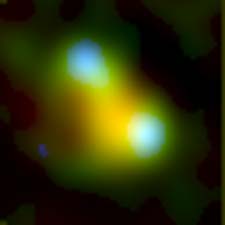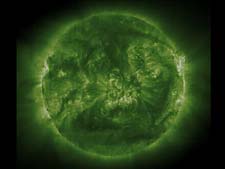|

|

|
NEWS
SEARCH
|
|
|
|

|
http://www.berkeley.edu/news/media/releases/2002/03/28_flare.html
Solar flare
satellite orbits into second month in space, gets new name:
RHESSI
28 March 2002
By Robert
Sanders, Media Relations
Video of
Feb. 20 solar flare
Berkeley – Nearly
two months after the Feb. 5 launch of NASA's solar flare satellite,
HESSI, the University of California, Berkeley, scientists who
designed and build it couldn't be happier. The satellite is working
flawlessly and has already captured numerous explosive flares as
well as X-ray and gamma ray flashes from elsewhere in the
cosmos.
 |

An X-ray snapshot of a solar flare,
colored to indicates the energy of the X-rays. Blue is the
most energetic and red is the least energetic. Presumably, Lin
said, the blue spots indicate that the more energetic
electrons are able to travel deeper into the solar atmosphere,
down to footpoints of the magnetic loop, while the less
energetic electrons, perhaps a hot thermal source, may be
trapped higher in the loop. Photo, UC Berkeley & NASA
Goddard |
"It's absolutely
beautiful," said Robert Lin, principal investigator for the HESSI
mission and professor of physics. "We have seen some really neat
stuff."
Lin also is
pleased that the satellite has been rechristened RHESSI – the Reuven
Ramaty High-Energy Solar Spectroscopic Imager – in honor of the late
NASA scientist who pioneered the fields of solar-flare physics,
gamma-ray astronomy and cosmic ray research. Ramaty died last year
of Lou Gehrig's disease after a long and distinguished career in the
Laboratory for High Energy Astrophysics at the NASA Goddard Space
Flight Center in Greenbelt, Md.
"He was one of
the people who pushed real hard to get HESSI funded," said Lin, who
proposed to NASA that it change the satellite's name to honor
Ramaty. "He was really looking forward to HESSI's launch, but he
passed away before the spacecraft went up. It's appropriate that we
name it after him."
RHESSI to date
has imaged more than 50 small and medium X-ray flares, though so far
no large solar flares emitting gamma rays. Flares are among the most
powerful events on the Sun, and can occasionally disrupt satellites,
communication systems and power grids on Earth. Scientists believe
solar flares are powered by the violent release of magnetic energy,
but how this happens is a mystery.
"Their behavior
is really amazing, much more complicated than people guessed
beforehand," Lin said. "They will take a while to
analyze."
 |

Video: this
movie records the X-ray and gamma radiation released
by a solar flare, energy equivalent to one million megatons of
TNT
|
NASA created a
movie of one of the flares superimposed on solar images from the
SOHO satellite (Solar & Heliospheric Observatory) and the
ground-based Big Bear Solar Observatory in California. This was an
explosion Feb. 20 in the atmosphere on the southern hemisphere of
the Sun, in an active region designated AR 9830. The blast was equal
to one million megatons of TNT and gave off powerful bursts of
X-rays.
"We are thrilled
to be making the first high-resolution movies of flares using their
high-energy radiation," said Brian Dennis, the RHESSI mission
scientist at Goddard. "We want to understand how solar flares can
explosively release so much energy. RHESSI shows us the high-energy
radiation emitted by flares: their X-rays and gamma rays. This
radiation reveals the core of the flare – the exact time and place
where the energy is released."
RHESSI also has
seen several non-solar events, including a soft gamma ray burster
and X-rays that may be from the black hole binary Cygnus X-1. These
X-rays and gamma rays penetrated the sides of the spacecraft and hit
the detectors, so they couldn't be turned into an image. But because
RHESSI has the best energy resolution for such high-energy radiation
of any satellite, Lin hopes the instruments can provide unique
information on these and other X-ray and gamma ray sources by
searching for emission and absorption lines and obtaining Doppler
shifts indicative of chemical composition and motions, respectively.
RHESSI also can study X-ray pulsars, which are stars that flash at
regular intervals.
The immediate
goal of the UC Berkeley RHESSI team, however, is to switch the
spacecraft over to automatic operation, so that the operations team
doesn't have to scramble every time the satellite passes over
Berkeley and downloads data, often in the middle of the night. Lin
is hopeful this will be achieved in early April.
During its
planned two-year mission, RHESSI will study the secrets of how solar
flares are produced in the Sun's atmosphere. RHESSI is the first
NASA Small Explorer mission managed in the "principal investigator"
mode, where Lin and his team are responsible for most aspects of the
mission, including the science instrument, spacecraft integration
and environmental testing, and spacecraft operations and data
analysis.
The RHESSI
scientific payload is a collaborative effort among UC Berkeley;
Goddard, the Paul Scherrer Institut in Switzerland and the Lawrence
Berkeley National Laboratory. The mission also involves additional
scientific participation from France, Japan, The Netherlands,
Scotland and Switzerland. |

|